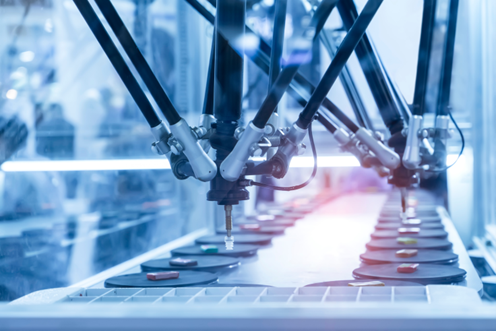In the following article, Collin Charlie Christopherson discusses some of the most remarkable advancements in medical device manufacturing, thanks to technology such as AI, machine learning, and 3D printing.
Over the past decade, medical device manufacturing has undergone a transformation driven by remarkable advancements that have revolutionized the industry. Several key innovations have emerged, empowering manufacturers to create cutting-edge devices with improved precision, efficiency, and patient outcomes.
Here are some notable technological innovations that have had a significant impact:
Collin Christopherson on the Importance of Additive Manufacturing
More commonly known as 3D printing, this technology has revolutionized medical device manufacturing by enabling the production of complex, patient-specific designs with greater customization. It has streamlined the prototyping process, reduced production time, and enhanced the ability to create intricate structures, such as implants, prosthetics, and surgical instruments.
Customization and Patient-Specific Designs: By allowing healthcare professionals to design and manufacture implants, prosthetics, and surgical instruments that precisely match a patient’s anatomy, they can enhance the functionality and fit of the devices. For example, patient-specific orthopedic implants can be manufactured based on a patient’s CT or MRI scans, ensuring a perfect match to the patient’s anatomy.
Complex Geometries: Collin Charlie Christopherson reports that 3D printing allows the fabrication of highly complex geometries that are otherwise challenging or impossible to produce using conventional manufacturing methods. This flexibility in design enables the creation of intricate lattice structures, porous implants for better osseointegration, and internal channels for fluid flow in devices like prosthetic limbs or surgical tools.
Rapid Prototyping: 3D printing significantly accelerates the prototyping process in medical device development. It enables designers and engineers to quickly produce physical prototypes, facilitating design improvements and reducing time to market.
Material Variety: 3D printing supports a wide range of materials suitable for medical device manufacturing, including biocompatible polymers, metals, ceramics, and even living cells for bioprinting applications. Each material possesses unique properties and can be tailored to a medical device.
Cost Efficiency: While 3D printing was initially considered expensive when this technology first appeared on the market, the fast-paced advancements and increased accessibility have significantly reduced costs. This eliminates the need for extensive tooling and complex assembly processes, leading to reduced production costs.
The Current Impact is Already Evident
Collin Christopherson reports that in 2019, the U.S. Food and Drug Administration (FDA) issued more than one-hundred 3D printing-related clearances and approvals for medical devices, indicating the increasing adoption of this technology in the industry.
Research studies have also demonstrated successful 3D-printed implants, such as cranial and facial implants, orthopedic implants, and customized prosthetics, leading to improved patient outcomes and reduced surgical complications.
As this technology continues to advance, it holds tremendous potential for further innovations in medical device manufacturing. The ability to create patient-specific devices, optimize designs for functionality, and explore new materials will undoubtedly pave the way for more advanced treatments, personalized healthcare, and improved patient satisfaction.
Artificial Intelligence (AI) Applications
Collin Christopherson says that AI and machine learning algorithms have yet to reach their full potential in medical device manufacturing. However, currently, this technology in its current state can provide predictive insights, contributing to more accurate and efficient manufacturing practices.
AI in Diagnostic Imaging
This technology has made significant strides in the field of diagnostic imaging, aiding radiologists and clinicians in detecting and diagnosing diseases with greater accuracy and efficiency. Some of the key applications include:
Image Analysis: AI algorithms can analyze medical images such as X-rays, CT scans, and MRIs to detect abnormalities, tumors, and other pathologies. AI-powered image analysis can assist in early detection, allowing for timely interventions and improved patient outcomes.
Computer-Aided Detection (CAD): CAD systems powered by AI can assist radiologists in detecting suspicious areas or potential abnormalities in medical images. These systems act as a “second pair of eyes,” increasing diagnostic accuracy and reducing the chances of missed diagnoses.
Quantitative Image Analysis: AI algorithms can extract quantitative data from medical images, enabling better quantification of disease progression and treatment response. This information aids in personalized treatment planning and monitoring.
AI for Predictive Analytics and Risk Assessment:
AI algorithms can sift through mountains of data, including electronic health records (EHRs), genetic information, and lifestyle factors, to identify patterns, predict outcomes, and assess individual risk profiles.
For example, Collin Charlie Christopherson explains that AI can identify early signs and risk factors for diseases such as cancer, cardiovascular conditions, and diabetes. This enables doctors to intervene proactively by personalizing a patient’s preventive care, aiding in better disease management.
Additionally, AI algorithms can predict patient outcomes based on historical data, assisting healthcare providers in making informed decisions regarding treatment plans and resource allocation. It can also assess an individual’s risk of developing certain conditions, aiding in targeted interventions and resource optimization.
AI-Powered Virtual Assistants and Chatbots
Collin Charlie Christopherson says that virtual assistants and chatbots driven by artificial intelligence technology are increasingly employed in healthcare settings to enhance patient experiences, improve access to information, and support healthcare professionals.
Chatbots can provide patients with personalized information, answer basic medical queries, and offer support for managing chronic conditions. In an office or hospital setting, AI-powered virtual assistants can assist in scheduling appointments, triaging patients based on symptom severity, and providing initial guidance before connecting with healthcare providers.
Moreover, AI algorithms can automate medical transcription, converting spoken language into written text, reducing administrative and human errors, and improving documentation accuracy.
In Conclusion
It’s important to note that the adoption of AI in healthcare does have its challenges related to data privacy, ethics, and regulatory compliance. However, striking a balance between such advancements while ensuring patient safety and privacy remains a crucial consideration.
Collin Charlie Christopherson notes that the application of AI in healthcare continues to evolve rapidly, with ongoing research and development to harness its full potential. As algorithms become more sophisticated and datasets grow, the possibilities for AI-driven solutions in disease diagnosis, treatment planning, and patient care are vast. Leveraging AI’s capabilities has the potential to revolutionize healthcare delivery, improving outcomes, enhancing efficiency, and transforming the patient experience.
These technological innovations have not only propelled medical device manufacturing forward but have also provided new possibilities for advanced treatments, personalized healthcare, and improved patient outcomes. As technology continues to evolve, the future of medical device manufacturing holds tremendous potential for further advancements, enabling the development of devices that are smarter, more accessible, and tailored to individual patient needs.








